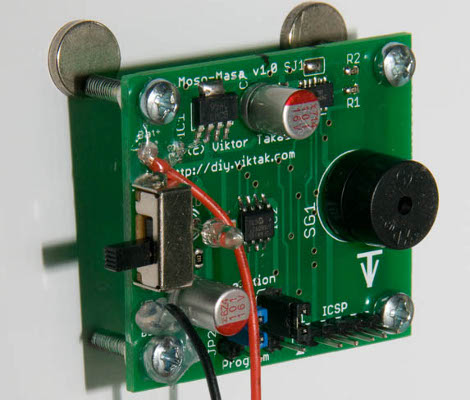
[Viktor’s] washing machine did a good job of cleaning his clothes, but it kept a bit too quiet about it. The machine doesn’t have an audible alert to let him know the cycle has finished. He decided to build his own alarm which can just be slapped on the side of the machine.
You can see that a couple of magnets hold the board to the metal housing of the washer. The board doesn’t actually connect to any of the machine’s circuitry so this should work about equally as well for any unit. The detection is based on motion, thanks to a Freescale MMA7361 3-axis accelerometer. When he starts a load of wash he flips the power switch for the board on. The PIC 12F683 that drives the device starts monitoring the accelerometer for changes. If it goes for more than about one minute without reading motion the piezo buzzer starts beeping. It’s a fun and easy solution along the same line of this oven pre-heat alarm add-on.















What about the mid cycle refill? I am doing laundry right now and I know that while it is washing it is vibrating like crazy (shakes my whole small house). But it stops as it refills the basket. So it this sensitive enough to detect the water flowing and splashing about?
Washing machines work on a basic TIMED CYCLE. Is it really that hard to figure out a full load at warm/warm takes 36 minutes and then set your phone to beep after that time?
My thoughts exactly, hell my machine even has a display that tells me how much time is left. While a neat device it just seems so overly elaborate for such a simple problem. But of course, if he had fun doing it and learned something along the way it’s worth it.
this is not true for many modern washing machines. many machines’ washing (and or drying) times depend on the amount of laundry
It isn’t “hard”, it’s “practically impossible”.
1) Here we don’t have simply “warm”, but an analog temperature dial instead, all the way from “off” to “90” or something. The dial is sometimes moved depending on type of clothes.
2) The machine takes water from the “cold” inlet, and during summer this “cold” might even become “lukewarm” for a first few gallons. (Amenities of a multi-apartment building.)
3) Amount of clothes varies from half to full.
4) The machine unlocks the door a few minutes after it stops. The trick is practically analog — a certain thing cools off and releases the latch.
Therefore guesswork has no sense. Fortunately the machine has no electronics whatsoever and nobody stops me from modifying the entrails. Monitoring when a certain AC voltage disappears would be an ideal job for ATtiny13… but AC requires a certain conditioning when going digital, and every idea that I find looks non-elegant and bulky to me.
Masive overkill. This could have been usefull when the older washers would kick out after trying to spin an unbalanced load of clothes. Aborting the timed cycle. Still this device has many uses.
Seems this could be done with the Chronos watch last seen in the Baby monitor hack.
good way not to void the warranty.
if you are up to voiding the warranty you could connect something to the machine’s finished indicator.
Nice, but seems like a massive overkill. Couldn’t you just us a timer!? Failing that, detect the drop in the power draw of the thing?
Nice build, but seems over engineered. Even newer washing machines have a schematic inside the back panel. why not get a buzzer and a relay/timer to go off when the cycle is done? his model is probably ready for a buzzer, it was just not included as a feature.
This reminded me of a few demos I’d seen back when the blogosphere wouldn’t shut up about Twine.
3 axis accelerometer??? WTF? Just use a tilt switch and save heaps of money and code! You can even make the switch reset a 555 timer periodically as the machine vibrates (a 555 configured in monostable mode. The tilt switch triggers it continously). When the timer is no longer re-triggering the 555, the output will go low.
Add a high pass filter that triggers a monostable timer for 30 seconds to make another 555 turn the buzzer on and off (not even necessary), add an astable oscillator to generate the tone for the buzzer, if it doesn’t already and you are done.
You can also ignore all the circuitry on the second paragraph and just stick one of those buzzers that generate their own tone to the output of the circuit in the first paragraph. And remember to add a power switch. That’s it. One 40 year old chip, a tilt switch and a buzzer, essentially. Jeez, you don’t even need a voltage regulator.
A tilt switch would be the worst possible solution. Unless you have a horribly unbalanced washer, you’re not going to get much motion. This means that in order to actuate the switch, it would need to positioned at a critical angle. A very slight change in this angle would break it, and could be caused by anything from bumping the sensor (or just the washer), to pushing the washer 1cm closer to the wall. It’s a pretty shit solution.
Making it based on an antique 555 doesn’t make things easier, it makes things harder. The microcontroller and the accelerometer cost basically nothing, and it allows the hardware to be made before the system is fully-defined. It allows things to work a hell of a lot better.
I tried something similar, my documentation was the insurance form saying “Put iPhone through washing machine”
Nice! I’m looking to build something myself, and your idea helps me decide how to do mine. Hopefully you ignored the negative comments.